If there’s one thing that everyone can agree on, it’s that the cannabidiol (CBD) industry is blowing up. But as a rapidly-emerging industry since the federal legalization of hemp in the 2018 Farm Bill, many questions linger about who exactly is using this trendy cananbinoid, what they’re using it for, and how well it works (especially considering that the CBD market is still unregulated by the FDA). Many claims are bandied about, but how many are backed up by hard data?
First, let’s review the basics. CBD is a cannabinoid derived from the cannabis plant, and, like medical marijuana, is purported to have a range of health benefits: among them, anti-inflammatory properties and the ability to reduce chronic pain.
We set out to get some answers on CBD users and the CBD market, and some of what we found may surprise you. To get these answers we tracked down and read through all of the largest available surveys on CBD users, with special weight given to surveys that featured nationally representative demographics when the data conflicted.
Our main sources for these statistics were:
- A survey of 2,400 medical cannabis users conducted by marketing & analytics research firm the Brightfield Group
- A nationally representative study of over 4,000 Americans conducted over 24 months by Consumer Reports
- A survey of over 2,000 Americans conducted by Quart & Harris Poll
- A study by New York investment bank Cowen & Co.
Collectively these surveys detail the views on CBD, usage habits, and CBD user demographics of more than 10,000 Americans. Bits and pieces can be gleaned from each individual study, but together they provide a striking (and strikingly positive) image of CBD use. On the whole, Americans (especially younger Americans) are well-aware of CBD and favor it’s medical use: Americans see it as having a wide range of positive effects and even consider it an effective treatment for a number of ailments, especially as an alternative to pharmaceuticals and OTC medications.
Keep in mind that, while these are the most exhaustive studies currently available, they’re far from definitive, and a clearer picture (with much more data) is sure to emerge as CBD continues its ascent to the top of the health-and-wellness mountain.
Read on to get a clear look at the CBD market — and the CBD user — in 2020.
CBD User Demographics Statistics
Summary: CBD is used by all age groups, but is most popular among the young. CBD use is distributed relatively amongst various income groups. Americans are very familiar with CBD, although the overall percentage of people who have tried it is relatively small (17%).
18-34 year-olds comprise 39% of hemp-derived CBD users
Only 8% of CBD users are aged 65 or older.
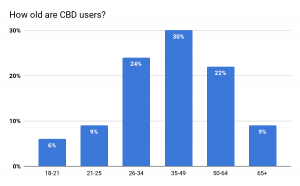
10% of Americans between ages 18-44 use CBD regularly
This might have something to do with the fact that anxiety is the most common ailment treated with CBD (see below), and millennials are experiencing anxiety at twice the average rate.
The 18-29 demographic is more open to CBD than any other: 40% of have tried CBD
In comparison, only 15% of those surveyed age 65 or older had tried CBD.
Western states are the most CBD-friendly
Of US adults that have tried CBD, 27% live in a Western state (the next most CBD-friendly region is the Midwest which represents 18% of CBD users). Colorado, in particular, is the hub of several top CBD companies and is also one of the cradles of hemp growth in the US.
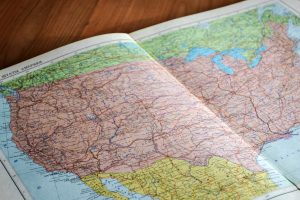
White Americans are more likely to use CBD than any other ethnicity
66% of CBD users surveyed by the Brightfield Group were caucasian.
Women are more likely to use CBD than men
55% of CBD users are female, while 44% of users are male.
Most CBD users are NOT single
43% of CBD users are married, and 61% of CBD users live with their significant other.
44% of hemp-derived CBD users are college graduates
Compared to only 34% of the population having a college degree.

44% of hemp-derived CBD users are middle class ($30k-$100k/year)
20% of hemp-derived CBD users earn less than $30k/year; 17% earn more than $100/year.
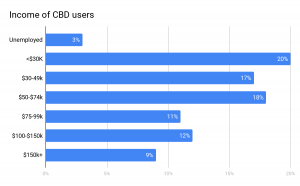
Americans overwhelmingly express support for CBD use, including as an alternative to pharmaceuticals
Of those who are familiar with CBD, over 80% support its use. 56% support using CBD as an alternative to pharmaceuticals.
86% of Americans have heard of CBD; 18% have tried it
The gap between the number of people familiar with CBD and the number who have tried it suggests there’s still plenty of growth potential in the CBD market.
7% of Americans are regular CBD users
Surveys vary on this point; another survey (from Consumer Reports) said that one in seven Americans had tried CBD (which is about 14%, or double the Press Herald number).
CBD Market and Sales Statistics
Summary: CBD markets are experiencing staggering and rapid growth, as interest in CBD grows exponentially. This has led to a proliferation of CBD purveyors, some of whom are less than reliable. The business end of CBD is being spearheaded by women, who have founded the overwhelming majority of CBD businesses.
The CBD market is projected to grow to nearly $2 billion by 2022
In 2017, CBD sales reached $367 million and ballooned to $845 billion by 2019, expected to reach $1.9 billion by 2022.

The CBD edibles market is projected to reach $4.1 billion in 2019
The same report states that CBD gummy sales increased by 925% in just a year.
The CBD beverage market is projected to reach $1.4 billion by 2023
The CBD beverage market was only $86 million in 2018, then jumped to $227 million in 2019.
Google Searches for “CBD” have more than quadrupled since 2017

“CBD gummies” were the third most-searched for food item on Google in 2018
The two top spots on the list? Unicorn cake and romaine lettuce.
Just over 400 banks and credit unions were banking marijuana-related businesses at the beginning of 2018, this increased to 633 by the end of Q1 2019.
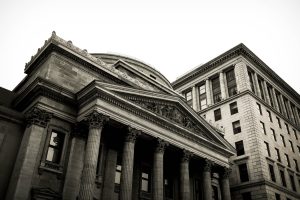
Charlotte’s Web is the most popular hemp-derived CBD brand in the US
Plus CBD Oil came in second, and Mary’s Medicinals in third.
Most CBD users get their CBD products from retail/storefront locations
55% of CBD users purchase their CBD products at storefront dispensaries, 31% through local delivery services, and 17% online
There are over 1000 CBD brands currently on the market
850 of these brands sell marijuana-derived CBD, while 150 sell hemp-derived CBD.

Nearly 70% of CBD products are mislabelled
This study found that 42.85% of tested CBD products were over-labelled (contained less CBD than claimed), while 26.19% were under-labelled (contained more CBD than claimed).
U.S. hemp acres tripled in 2017-2018
Farmers are rapidly mobilizing to capitalize on the CBD craze: in 2017, only 25,713 acres in the United States were devoted to hemp agriculture, in 2019 this jumped to 78,176 acres.
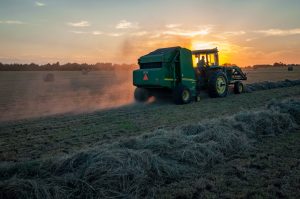
The availability of CBD in the US increased by 80% in 2018 alone
The market reached $519 million.
Women are founders or general managers of over 75% of CBD brands
This statistic was taken from online CBD marketplace Eaze Wellness, which ships CBD products to 41 states across the US.
Statistics on CBD Use
Summary: CBD is commonly used both to alleviate specific ailments and as an overall relaxer/stress-reliever. CBD users rate their experience with CBD very positively (especially relative to pharmaceutical alternatives).
People most commonly use CBD for relaxation; anxiety is the most common ailment treated with CBD
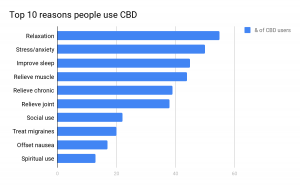 80% of CBD users found the CBD products they use to be either “effective” or “very effective”
80% of CBD users found the CBD products they use to be either “effective” or “very effective”
This finding is consistent across surveys: a huge majority of CBD users are pleased with the effectiveness of the CBD products they use.
52% of CBD users consider CBD to be “more effective” or “much more effective” in relieving medical conditions than Over the Counter (OTC) products
This is true for both hemp-derived CBD users and marijuana-derived CBD users.
22% of CBD users replaced some type of medication with CBD
Many people turn to CBD because it is a plant-based remedy with very few side-effects compared to some OTC/prescription medications. .

Of those who replaced some type medication with CBD, 36% replaced a pharmaceutical opioid (oxycodone, percocet, etc.)
Given that the opioid crisis is ravaging middle america, this statistic is potentially of huge importance if CBD can replace opioids for a significant number of people.
CBD-infused drinks and edibles are the most popular form of CBD
Vaping and consuming CBD via a tincture or edible rank as the next most popular forms of consumption.
74% of CBD users experience NO side effects
This is one of the big selling points of CBD, and is consistent across surveys.
Millenials use CBD more for stress and anxiety, baby boomers use CBD more for joint pain
32% of millenial CBD users use CBD for stress and anxiety, compared to 12% of boomers. Meanwhile, 42% of boomers user CBD for joint pain, compared to only 15% of millenials (not much surprise there, really).
Among CBD users, 41% use CBD every day
Only 4% of CBD users are occasional users (use CBD less than once per month).
70% of CBD users also use THC-dominant products
However, those who use both cananbidiol (CBD)-dominant and tetrahydrocannabinol (THC)-dominant products spend significantly less on THC-dominant products than those who use THC products alone.
Conclusion
The gap between the number of people who have heard of CBD and the number who have tried it indicates there’s still a lot of growth potential, especially considering how CBD-friendly young folks are and the generally positive attitudes Americans have towards CBD. Add to that CBD’s broad applicability and the fact that users report overwhelmingly positive experiences, and you’ve got the makings of a true health and wellness juggernaut that’s on its way up.
Sources
- https://daks2k3a4ib2z.cloudfront.net/595e80a3d32ef41bfa200178/59946dd86c6b200001c5b9cb_CBD_-_HelloMD_Brightfield_Study_-_Expert_Report_-_FINAL.pdf
- https://www.consumerreports.org/cbd/cbd-goes-mainstream/
- https://qz.com/1590765/survey-shows-americans-use-cbd-to-treat-anxiety-and-stress/
- https://www.forbes.com/sites/irisdorbian/2019/03/12/cbd-market-could-pull-in-16-bln-by-2025-says-study/#3e0bbaee3efd
- https://qz.com/work/1483697/millennials-experience-work-disrupting-anxiety-at-twice-the-us-average-rate/
- https://www.pressherald.com/2019/02/25/analysis-nearly-7-percent-of-americans-use-cbd-cannabis-compound/
- https://www.theatlas.com/charts/BkicPNTKV
- https://www.getlimelight.com/learn/ecommerce-trends/now-is-the-time-to-start-your-cbd-ecommerce-business/
- https://www.forbes.com/sites/debraborchardt/2017/08/02/people-who-use-cannabis-cbd-products-stop-taking-traditional-medicines/#e6b7c5228170
- https://www.ncbi.nlm.nih.gov/pmc/articles/PMC5818782/
- https://www.directsellingnews.com/cbd-sellers-highlighted-chi-tribune/
- https://www.greenentrepreneur.com/article/332514
- https://loudcloudhealth.com/cbd-statistics-infographic/
- https://mjbizdaily.com/chart-us-banks-serving-cannabis-firms-growing-data-may-overstate-true-number/
- https://www.visualcapitalist.com/boom-in-the-cbd-beverage-market/
- https://www.marketwatch.com/press-release/cbd-infused-edible-market-projected-to-be-41-billion-in-2019-2019-04-23-16183250
